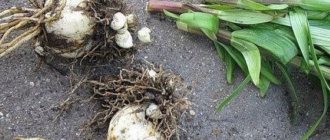The desire to see flowering plants in the house before they bloom in the garden is understandable. Flowers lift your spirits and increase your productivity.
Earning or saving money on buying flowers when the main women's holiday approaches is an incentive to start forcing flowers.
Lilies have become a popular plant species for this. Plants have a variety of colors, it is easy to predict the time of appearance of buds.
Selection of hybrids for forcing
The lily genus consists of more than 100 species. In the 18th century, the first attempts to produce hydrides were made in Japan. European breeders took up the flower in earnest in the 50s of the 20th century.
Over 5,000 varieties are officially registered, divided into 8 subspecies:
- Asian hybrids
- Snow-white;
- American;
- Tubular;
- Curly;
- Eastern;
- Orleans;
- Long-flowered.
Not every species is suitable for forcing by March 8th.
To obtain buds that bloom at the required time, the grower must be sure of the uniformity of the plants and the simultaneous appearance of flowers. The period of 120 days from planting to flowering makes the cultivation of some varieties unprofitable.
Asian, Tubular, Oriental and Long-flowered hybrids are adapted for winter forcing.
To obtain flowers at the required time, OT hybrids (obtained by crossing Tubular and Oriental lilies) and LA hybrids (their “parents” Asian and Long-flowered species) are planted.
Forcing tulips on March 8
Tulip bulbs for forcing
Tulips are easy to force, and the most important condition for successfully growing these flowers in winter is well-organized artificial lighting. But first you need to determine which bulbs are suitable for forcing and which are not. To grow tulips at home in winter, you need extra bulbs with a diameter of 12/12+ (which means 40 mm or more in circumference), first or second parsing (from 30 to 40 mm in circumference) - the larger the bulb, the larger the flower.
- How to transplant cyclamen into a new pot
But size isn't everything. It is also important what the weight of the bulb is, since a heavier bulb is a sign that it already contains a flower bud. It happens that small bulbs are heavier than large ones, which are simply overfed with nitrogen. Bulbs weighing less than 25 g are not suitable for forcing.
When to plant for forcing
According to the timing of flowering, forcing can be early (forcing tulips before the New Year and before Orthodox Christmas), medium (flowering lasts throughout January) and late (flowering from February to March, and sometimes until April). In order to grow tulips by a specific date, you need to know when to start forcing. Early forcing of tulip bulbs requires planting in late summer or early autumn, and forcing on March 8, like the middle forcing, requires planting the bulbs during October-November.
for early forcing : Apricot Beauty, Brilliant Star, Dixis Favorite, Christmas Marvel, Lustige Battle. For the average: Scarborough, Confux, Apeldoorn and Oxford. For late forcing, dedicated to International Women's Day, the following varieties are suitable: Parade, Diplomat, Vivex, London, Kis Nelis and Eric Hofsier.
Forcing tulips at home
So, we found out that forcing tulips by March 8 requires planting the bulbs in late October or early November. Before planting, peel the covering scales from the bulbs to inspect them for disease damage and also to speed up their rooting. Treat the bulbs with a bright pink disinfectant solution of potassium permanganate.
Planting and caring for tulips in the garden
The optimal substrate for forcing tulips is a mixture of one part river sand, one part compost or rotted manure and two parts garden soil with the addition of some wood ash. Fill the forcing container two-thirds full with this substrate and compact it slightly, then place the tulip bulbs on the surface at a distance of 1 cm from each other and lightly press their bottoms into the soil. Fill the containers to the top with the same substrate or clean sand and pour generously with a two percent solution of calcium nitrate.
If the soil settles from the liquid and the tops of the bulbs are exposed, add more sand or substrate so that there is a small layer of soil above the bulbs - 1-2 cm, then place the container in a dark place with a temperature of 5-9 ºC at an air humidity of about 75%. Do not allow the substrate to dry out; water it daily if necessary. As soon as sprouts appear, the temperature should be reduced to 2 ºC. About three weeks before the target date, place the container in a dark room with a temperature of about 13 ºC, and four days later place the sprouted bulbs in a bright room with a temperature of 16-18 ºC.
Now is the time to use additional lighting to increase the daylight hours for growing tulips to the required 10 hours. If the day is shorter, the tulips will begin to stretch painfully. When the buds acquire the color characteristic of the variety, the temperature must be lowered by a couple of degrees - this will make flowering longer and brighter. Caring for blooming tulips involves regular watering of the plants and periodic feeding with calcium nitrate.
Forcing tulips in a greenhouse is practiced mainly to obtain a large number of flowers for sale.
Choosing a lily variety for forcing
Based on the timing of forcing, the following varieties and hybrids are recommended for planting:
"Mlada" - flowers of soft apricot color without spots, 14-15 cm in diameter. The height of the stems is 100-120 cm. Recommended for all regions. Asian hybrid.
“Siberian” is an Asian type lily, red in color.
"Andromeda" is a hybrid of the Asian type, yellow in color with dark spots in the center.
“Amarossi” is a red-pink hybrid with a white border of petals, shoot height 110-130 cm.
“Aventino” is a hybrid, pink with a yellow center, height 120 cm.
“Beverlys Dream” is a wine-red flower with a yellow star in the center and a white border around the edge of the petal, up to 100 cm.
"Villa Blanca" - pure white flowers with pink veins on the back, diameter up to 23 cm, height 120 cm.
Text of the book “Business plan for growing lilies”
Biological characteristics of lilies
Some wild species and hybrid lilies lay renewal buds in August 2 years before the start of the growing season.
Within 3 months, rudiments of scales form in the bud, then in October, November or March-April, rudiments of stem leaves are formed, which are similar in shape and structure. In July or August, leaf formation ends. Simultaneously with the formation of leaves, new adventitious roots are laid in the tissue of the root part of the bottom of the bulb. 10–20 days after the initiation of leaves in the renewal bud, the renewal bud of the next generation is formed in the internodes behind the last scale and the first green leaf. In August, the formation of flowers begins in the renewal bud over the entire surface of the growth cone. The flowers are located in the axils of the ridges of the bract primordia. The formation of flowers lasts 2 - 2.5 months and ends in October. From the initiation of a bud to the end of the growing season of a monocarpic shoot, 24 months pass, and only 4 months does the shoot vegetate. From the moment of flower initiation to the end of flowering, 11–12 months pass, of which 9 months are inside the bud, in the bulb.
The bulbs that store the scales, which are connected to the bottom for 3 to 4 years, have the longest life expectancy. In the above lilies, the peduncle and flowers are fully formed in the fall inside the bulb.
American and Western China lilies develop in a different rhythm. Renewal buds in this group are formed 1 year before flowering, in May. In these varieties, storage scales are formed until July–August, and then in September, October, November, the buds of green leaves are formed. The subsequent stages of organogenesis take place in the spring of the following year.
In April-May, a flower shoot appears above the soil surface, in the growth cone of which the rudiments of flowers are laid. Their formation continues for 1.5 - 2 months, and flowering occurs in July. From the initiation of the renewal bud to the end of the growing season, developing from the shoot bud, 17–18 months pass, the formation of flowers – 3 months, leaves – 12–13 months (of which 7 months inside the bud).
Wild species of lilies from Japan, Southern China, India and garden Oriental hybrid lilies are characterized by the fact that a renewal bud is formed in the bulb in the summer a year before flowering. During the summer and autumn months, storage scales and part of the primordia of stem leaves are formed in it. In spring, the formation of leaf primordia continues. Flowers are formed in the upper part of the shoot outside the bulb, but this period lasts 30 - 40 days longer than in American varieties and hybrids.
During the period of the beginning of flower differentiation, another new renewal bud is formed at the base of the shoot.
Technology of growing lilies. Lily propagation.
The easiest way to propagate lilies is to use daughter bulbs.
As they grow, the daughter bulbs form an independent root system and a renewal bud, from which a new flower stem grows. The resulting “nest” of bulbs is divided every 3 to 4 years.
In some varieties, stem babies - bulbs - are formed in the underground part of the stem, which in 2-3 years of cultivation turn into adult bulbs that replenish the “nest”. During propagation, they are separated and planted for growing on ridges.
Method of propagating lilies using bulb scales.
With this method, in the spring or after flowering, the outer scales of large bulbs are separated at the very base, usually half of the existing scales are removed. Selected scales are washed in clean water and disinfected in a 0.2% benlate solution. After disinfection, the scales are slightly dried and placed in plastic bags filled with perlite or sand with a humidity of 80 - 85%. The bags are sealed and stored for 6 weeks at a temperature of 22 - 25 ° C, then 4 weeks at a temperature of 17 - 18 ° C. After this, the plants in bags are placed in the refrigerator at 2 ° C until planting. Scales with formed children are planted in late August - early September on ridges in open ground or in greenhouses. Planting prepared scales in boxes in a greenhouse gives good results. For the winter, the ridges are mulched with peat or leaf soil.
A baby grown from scales blooms in the second or third year after planting.
Lilies can also be propagated by baby bulbs (formed on stems in the axils of green leaves).
Baby bulbs are formed in some varieties after flowering.
Removing flowers (or buds) promotes the formation of larger bulbs. The collected bulbs are grown, like the children obtained from the scales of the bulb. They are planted on well-prepared ridges in transverse furrows at a distance of 20 cm, planting depth - 2 - 3 cm, distance between bulbs 4 cm. Ridges with planted bulbs are mulched with peat, humus or leaf soil.
Plants grown from bulbs bloom in the second or third year. Bulbs for forcing using this method can be obtained after 3–4 years of cultivation.
Propagation of lilies by seeds is possible, but in practice it is used only for wild species.
Selecting a site and planting lilies.
Areas intended for growing lilies should have light soil and be well lit by the sun in the morning. It is important that fields and plots are carefully leveled and provided with drainage, since stagnation of rain and groundwater leads to the death of the bulbs. The occurrence of groundwater on light soils should be no higher than 80–100 cm.
Since lilies are grown without replanting in one area for 3 to 4 years, it is important to prepare the soil well in advance. For lilies that form supra-bulbous stem roots, soil cultivation is carried out to a depth of 40 - 50 cm.
Before plowing, manure or leaf humus is added to the soil at the rate of 100 t/ha and the acidity of the soil is systematically controlled, maintaining it at a pH level of 6.0 - 7.0. The best time for planting and replanting in temperate climates is the end of August - September. Lilies are planted on beds raised by 10–15 cm.
The distance when planting on ridges depends on the size of the bulbs and is 30 x 30 cm, and for smaller fractions - 20 x 10 cm.
Large bulbs can be planted under a plow or cultivator in single-line and double-line furrows, maintaining a distance between lines of 70 cm, between double-line furrows - 20 cm. Bulbs are planted in furrows every 30 - 40 cm.
When planting, special attention should be paid to the depth of planting of the bulbs, which depends on their belonging to a certain section and size.
Lily varieties recommended for subsequent forcing from sections I, VI, VII form stem (supra-bulb) roots and need to be planted to a depth of 15–25 cm. When digging and planting bulbs, it is necessary to carefully preserve the roots from drying out and damage. In areas with harsh winters, in the year of planting or replanting lilies, it is necessary to mulch the areas with peat and cover them with leaves and spruce branches with a layer of 15–20 cm.
Caring for lilies in the spring begins with removing the cover. Subsequent care of lilies comes down to systematic watering, loosening the soil and removing weeds, paying attention not to damage the stem roots. In addition, during the growing season, fertilizing is applied every 10–15 days in the form of a complex water-soluble fertilizer at the rate of 20 g/m2, followed by abundant watering.
Forcing lilies. Basic Rules:
1. For forcing, it is necessary to select cultivars mainly with “upward looking” buds; they are easier to pack and transport. The exception is all varieties of long-flowered hybrids in which the flowers are directed to the side.
2. Unpacked boxes with planting material cannot be left in bright light; they must be covered from direct sunlight.
3. The bulbs are planted in a moderately moist (not overdried) substrate, then watered abundantly.
4. If the sprout is large, then it is oriented strictly vertically, since otherwise it does not straighten and remains a “hook”.
5. If the shoot is too elongated, the bulbs are buried more than normal so that stem roots form underground.
6. Optimal temperature during the rooting period: soil – 9 °C, air – 12 – 13 °C.
7. In greenhouses with contour heating, tall varieties are planted further from the heating, and low-growing varieties are planted closer.
8. If the room temperature rises above 40 °C, burns may appear on the buds; shading and ventilation are necessary.
9. The larger the bulbs, the greater the likelihood of leaf burn.
10. It is more economical to use early varieties for winter forcing, and late varieties for summer forcing.
Preparing lily bulbs before planting for forcing
After the growing season is completed, lilies are dug up in October and large bulbs are selected. During harvesting and further operations, they try to preserve the main root system (from the bottom of the bulbs) and protect the bulbs from drying out. For this purpose, the bulbs are dropped into wet peat (or sand, perlite) in plastic boxes, which are placed in refrigeration chambers at a temperature of 2 ° C and air and substrate humidity of 96 - 98%.
For full flowering of lily plants in forcing, the period of cooling the bulbs in the refrigerator for varieties of Asian hybrids is 6 weeks and for varieties from sections V, VI, VII - 8 weeks.
Bulbs prepared in this way are used for flowering in December, January, February, March. For longer storage and forcing in later periods (April, May, June), after harvesting from the field, the bulbs are stored for the first 6 - 8 weeks at a temperature of 2 ° C, then the temperature drops to 1 - 0 ° C.
In the case when forcing is planned in August-September, it is possible to freeze the bulbs at a temperature of - 1 ° C (lower is not possible!) until the required moment of moving to the greenhouse.
When storing bulbs in the refrigerator, you should completely exclude the possibility of the roots and scales of the bulbs drying out, otherwise this can lead to curvature of the stem, a decrease in plant height and an increase in the period until flowering.
Thus, the quality of planting material and the condition of the root system are important factors when forcing lilies.
Particular attention should be paid to the fact that all species and varieties used in forcing form supra-bulbous, stem roots, which provide the flower stem with nutrients and moisture. To obtain the best quality flower stems, serious attention must be paid to the optimal development of the stem roots. For this purpose, it is necessary to plant the bulbs at a depth of 7 - 10 cm above the top of the bulbs. It is also necessary to correctly compose the soil substrate, which must be air- and water-permeable and have a sufficient supply of ash elements. The best substrate can be considered a mixture consisting of 1 part rotted manure (or leaf soil), 1 part peat and 1 part sand (pH 6.5 - 7). Before planting the bulbs, the soil substrate must be disinfected by steaming.
Complex fertilizers are added to poor soil mixtures before planting bulbs.
When growing lilies in the soil of a greenhouse or in deep shelves, mineral fertilizers are applied during the period of growth of flower stems in an amount of 30 g/m2. In these cases, from 80 to 40 bulbs are planted per 1 m2, depending on their size and timing of forcing. Thus, when planting in the early stages (in December), the plant density is increased by 25% compared to a later planting date.
Stem roots in lilies are maximally formed within 2 weeks after planting. During this period, the optimal soil temperature is 9 °C, air temperature is 12 – 13 °C. In the hot season, the substrate must be cooled, for which you can use shading and mulching the plantings with fresh sawdust.
After planting, constantly water the substrate. Its top layer must be constantly moist during the rooting period. With a lack of moisture, the development of the shoot outstrips the growth of the stem roots, which further deteriorates the quality of cutting. If watered irregularly, the buds may dry out and turn brown.
Overmoistening during the growth period also negatively affects plants: the lower leaves turn yellow and fall off, and the roots rot.
To prevent internodes from stretching, in the autumn-winter period the temperature in the greenhouse should be about 16 °C for Oriental hybrids and not higher than 14 °C for other varieties. Higher temperatures weaken the peduncle.
In the autumn-winter-spring period, additional illumination of plants is necessary for about 16 hours a day.
The reason for the drying out and dropping of buds during this period is high temperature and low light. At night you can maintain 10°C, and during the day, during the additional lighting period, 12°C.
With a lack of light, the buds dry out. The stage is especially dangerous when their length reaches 2 cm. At this time, you need to carefully monitor the temperature in the greenhouse.
Lilies need good air exchange. The greenhouse should be equipped with forced ventilation, which in the summer protects the buds from burns and reduces the temperature on the surface of the leaves. Watering with cold water reduces soil heating.
In damp weather with poor air exchange, there is a danger of developing gray rot (botrytis). Therefore, it is better to water the plants in the morning so that no drops of water remain on them by night.
When growing lilies, salinization of the substrate is dangerous, which leads to poor plant development.
The first feeding is carried out after massive regrowth of stem roots. Lilies respond well to foliar fertilizing with complex fertilizers; root fertilizing is done with drip irrigation.
Lilies are cut at the stage of two colored buds and packaged in 10 pieces. in technology bags (70 x 40 x 12 cm). Then they are placed in cardboard boxes and stored in a chamber at a temperature of 2 - 3 ° C until sale.
Diseases and pests
Leaf chlorosis.
It is more often found in Eastern Hybrids in the autumn-winter period when the pH value of the substrate is high and it is waterlogged. If you temporarily stop watering and lower the pH by adding orthophosphoric or nitric acid or acidifying fertilizers, such as ammonium nitrate, chlorosis disappears. According to Dutch experts, the optimal pH value for Japanese, Chinese lilies and Oriental hybrids is 5.5 - 6.5, others prefer slightly acidic and close to neutral soils with a pH of 6.0 - 7.0.
Leaf burn.
This is a physiological disorder caused by an imbalance in the absorption and evaporation of moisture. During the budding period, the middle part of the leaf blade narrows, becomes lighter, then turns brown and becomes deformed. Oriental Hybrids may produce ugly buds. We do not recommend using large bulbs if the varieties are not resistant to leaf blight. To avoid this phenomenon in summer, it is necessary to additionally shade the plants, for example, with white spandbond, for 2 weeks before the buds appear. Leaf scorch can also occur with high air humidity.
Gray mold, botrytis.
Is an infectious disease. Brown spots appear on leaves and buds. Reason: poor ventilation, high relative humidity. Control measures: spraying with copper-containing preparations, morning watering of plants.
Root rot.
Damages root hairs, especially in the hot season. Control measures: reduce the temperature in the greenhouse as much as possible, treat with an approved fungicide.
Pests. Aphids cause the most damage. If the treatment is not carried out in time, the buds will become deformed and the plants will lose their presentation. There is a huge list of drugs against aphids; it is important not to delay treatment and alternate drugs.
Table 1. Economic efficiency of hydroponic production of cut lilies
Rules for cutting and storing flower products
Each type of flower product has its own optimal flower ripening period for cutting. In many cases, this period coincides with the earliest stage of flower development - budding. Within each crop, the cutting time is determined by the species and varietal characteristics of the plants. Thus, individual varieties differ greatly from each other in their ability to open buds. The more petals there are in buds, for example, roses, the slower they open. Therefore, the more pronounced the doubleness of the flowers, the later the stage of ripening they are cut off. Otherwise, the flowers may not open at all.
The general rules for preserving certain types of flower crops from the moment they are picked from the bush until sent to a warehouse or distribution network, regardless of the time and growing conditions, are as follows:
1. Roses are cut at the stage of colored bud and half-opening. Full-double varieties of roses (Baccarat) open more slowly, so they need to be cut later, when the petals appear. Moreover, the flowers of these varieties should have sepals that are completely bent downwards, with the outer petals freed.
2. Remontant carnation, cut at the stage of a barely colored bud, does not open in water, since for further growth and development the flower lacks energy potential, which can only be provided through the influx of nutrients from the root system. The most suitable stage of carnation flower development for cutting is the half-opening stage, when the outer petals bend outward at a right angle. If you do not cut carnation flowers on time during the period of mass flowering in the summer, then after two or three days at a relatively high air temperature and good natural light in the greenhouse, a rapid mass opening of flowers begins and they lose their commercial quality, i.e. a so-called recolor is formed.
3. Daffodils are picked at the bud stage - at the beginning of dissolution, when the flowers have a “gooseneck” shape.
4. Tulips are cut when a barely colored bud is formed.
5. It is customary to cut chrysanthemums with fully developed reed flowers after the green color disappears in the middle of the inflorescence.
Factors that determine color fastness
1. Flowers cut on a hot sunny afternoon quickly lose water and wither. Even a quick transfer of flowers cut at this time to a cool room and installation in water only partially restores their decorative value. Flowers remain damaged, and their life expectancy after cutting no longer reaches the duration characteristic of this crop.
2. To improve the quality and durability of cut flowers, harvesting is done only early in the morning or late in the evening. The daily maximum carbohydrate content in the leaves is observed in the summer between 16:00 and 18:00, in spring and autumn - between 14:00 and 16:00. After this, the best time for collection comes from a physiological point of view, since the leaves contain large quantities of carbohydrates accumulated during the day.
3. Roses grown in protected soil conditions do not tolerate high temperatures very well. In this regard, it is advisable to cut them at a cooler time - early in the morning.
4. Harvesting should not be done after watering, as moisture will cause the petals to rot and lose their decorative properties.
5. Picked flowers intended for long-term storage are kept with their heads down for some time.
6. The lifespan of cut flowers is also affected by the time of year in which they are grown and environmental conditions. Cut carnations and roses harvested in winter and spring-autumn have the longest life expectancy.
7. When growing cut flowers, one-sided or excessive nitrogen fertilizer should be avoided during bud formation.
8. Plants should be provided with sufficient moisture in the summer, since if there is a lack of moisture, the plants become very woody, which makes it difficult to absorb water after cutting.
9. Changes in temperature and relative air humidity should not be allowed when growing plants and when storing them after cutting.
10. It is necessary to leave as few leaves as possible on cut plants and remove all those located at the base of the shoot, which reduces water loss due to transpiration by the plants.
11. Periodically update the cut and, if necessary, split the peduncle.
Correct removal of flowering shoots from plants
● Roses must be cut with sharp pruning shears.
● Repairing carnations are usually not cut, but broken off at the nodes. After this, the flowers are removed from the garter downwards so as not to damage the shoots that continue to develop.
● It is also better to break off shoots of daffodil and tulip flowers.
Processing of flower products after cutting
First, the flowers are quickly transferred to special sorting and packaging rooms with a low temperature (10...15 ° C) and high relative humidity (70...90%). Here flowers are distributed according to species, variety and product characteristics. Then flowers of uniform quality are collected into bunches of 25...50 flowering shoots each, the tips of the stems are cut again under water with sharp pruners (or a knife) and placed in vessels with a nutrient solution. Repeated pruning under water is a mandatory operation, eliminating the possibility of clogging the conductive paths of the flowering shoot with air, oxidation products, salts, and bacteria. Only after the described operation will cut flowers be able to actively absorb water or nutrient solution and restore turgor, and, consequently, decorativeness.
Flower containers must be clean, made of neutral, non-oxidizing material. Plastic buckets may work. It is also necessary to remember about the physiological incompatibility of most types of flowers cut and placed together in one tank. The probability of rapid death of flowers of different species placed in one vessel is much higher than those placed in separate vessels.
Cut flowers are usually subjected to primary processing 24…48 hours before sale. During this period, the flowers receive a sufficient supply of water and carbohydrates, which will help them endure subsequent packaging, transportation and the sales period.
Selection and preparation of planting material
Planting material can be purchased from trusted manufacturers or grown independently.
When purchasing planting material, be sure to pay attention to several important points:
- A careful approach to the selection of planting material is the main condition not to be disappointed in the results of forcing. Some points deserve attention:
- The diameter of the bulbs intended for planting should be within 3-20 cm. Instances less than 3 centimeters do not have the necessary supply of nutrients necessary for quick winter forcing;
- Any stains or traces of rot on the surface of the bulb are unacceptable.
- The bottom of the bulb should not be damaged; rotten or dry roots are not allowed.
- The presence of “awakened” sprouts is allowed only if the plant is immediately planted. Do not throw out bulbs with elongated sprouts. Only the presence of a slightly hatched one is acceptable.
- Dry and loose bulbs are not suitable for planting. The best material for planting will be dense and juicy bulbs, densely covered with scales.
The sale of bulbs by gardeners significantly below the average market price indicates that these are bulbs after forcing. Such specimens will bloom 2-3 years after planting in the ground. They are not suitable for winter forcing.
The bulbs of different varieties of lilies have different colors: yellow, red pink, white, brown. You can avoid deception and substitution of varieties when selling by reading the descriptions of the varieties. Each variety has its own bulb color.
Bulbs purchased in specialized stores, as a rule, have been fully prepared for planting - properly dried and treated with antifungal agents.
Hybrids of the LA type, for the purpose of harvesting planting material for winter forcing, are successfully grown on their own plot. Plants reproduce quickly in the ground in summer.
Plants intended for winter forcing are not used for cutting. The buds are removed before blooming. When digging, they try to preserve the roots and prevent the bulbs from drying out.
What kind of land do lilies need?
Particular attention should be paid to the soil. When mass forcing, many professional flower growers use pine sawdust. In them, the bulb develops primarily due to the nutrients accumulated in it, as well as due to additionally introduced mineral fertilizers. In addition, sawdust retains moisture very well.
The disadvantage of this method is that after receiving the flowers, the lily bulbs are completely depleted and can only be thrown away. Therefore, at home, it is advisable to prefer a nutritious, well-structured substrate with drainage to sawdust. In this case, the bulb itself will not only retain most of its internal reserves, but will also give birth to a baby.
Stages of bulb preparation
For full winter flowering, planting material must go through several stages of preparation. One of them is the cooling period.
First way
The bulbs, immediately after digging, are planted in pre-prepared containers filled with slightly moistened soil. Further, at a temperature of 4-6ºC, the processes of rooting and cooling occur simultaneously.
Second way
Known as the dry cooling method. The bulbs are placed in boxes and sprinkled with slightly moistened sawdust. The boxes are stored in a dark room at a temperature not exceeding 2 °C. The bulbs are left in this position until planting for forcing.
For Asian hybrids, the dry period is limited to six weeks. Long-flowered, LA hybrids, Tubular and Oriental hybrids last up to eight weeks.
It is imperative to ensure that the planting material does not dry out.
In case of continued storage, the temperature is reduced to 0C.
Before planting, the bulbs are disinfected. Specialized stores offer modern disinfection preparations. Dosage and preparation instructions are indicated on the packaging.
You can make your own garlic solution. To do this, the juice of four cloves is dissolved in 1 liter of water. Soaking time is limited to two hours.
Preparing for winter
Caring for lilies in the autumn consists of:
- Stop watering from September. If the weather is rainy, cover the bush with film or a piece of linoleum to prevent the bulbs from rotting.
- Stop loosening the soil.
- Lilies cannot be trimmed immediately after flowering. They are left to dry naturally until late autumn.
- Fertilizing with mineral fertilizers containing potassium and phosphorus - superphosphate and potassium monophosphate.
- If storage is indoors, dig up the bulbs and remove the stems. If in open ground, prune at the end of October - November.
Lily pruning
With any method of wintering - in the ground or with digging, dead stems must be cut off. To do this, cut off the shoots completely. In the garden, right in the flowerbed, it is enough to turn the stem around its axis and it will break off. The bulbs with roots remain in the ground. If you dig up a bush, you can cut off the shoots at the root. Treat the cut areas with crushed coal or fungicide solution.
Important! There is no need to leave stumps when pruning. When the stem dries out inside, it will become hollow and fill with water, causing the bulb to rot and disappear.
Preparing the substrate for planting
Any substrate is suitable for forcing lilies, however, to obtain stable results, take care of preparing the land in advance.
Plants grow well in light mixtures with a high organic content. This composition is suitable for proper and rapid development of the root system.
You can use neutral peat, enriching it with mineral fertilizers.
Self-prepared and purchased soil must be disinfected by steaming. Additional treatment with fungicides will make the soil safe for plants.
Growing flowers in a greenhouse is a million-dollar idea
The idea has the right to life and is becoming especially popular due to rising prices for foreign bulbs. Farmers and flower growers, analyzing the sales market, are gradually coming to the conclusion that producing a domestic product for sale in Russia is much more profitable than importing it.
Before drawing up a plan, an entrepreneur must understand all the features of this industry.
Among the nuances of the flower business, we highlight the following points:
- Seasonality. In the warm months of the year, demand for products falls, and in the cold season, sales increase and business goes up.
- Competition and the need for price regulation. During periods of decline in demand, it is advisable to make discounts and create marketing offers that can increase wholesale sales.
- Floriculture experience and knowledge. Basic standards of plant care and subtleties of greenhouse improvement will be needed to eliminate the risk of seedling death and loss of investment.
You will understand and study other subtleties and nuances on your own in the process of work.
Planting bulbs
The planting depth should provide a 10 cm layer of soil above the bulbs; in this case, adventitious roots are formed on the stem, which are necessary for additional nutrition of the plant.
The layer of soil under the bulb is from 1 to 4 cm; there is no need for more.
The plants are kept in the dark until shoots appear.
The planting density should provide sufficient lighting. Plants that will bloom in winter are planted less often than those intended to produce flowers in the spring.
After the shoots appear, the lilies are brought out into the light.
Do not use containers that are too large for planting. During the forcing process, it may be necessary to regularly move plants (to maintain temperature conditions) between different rooms.
Forcing crocuses by March 8
Forcing bulbs at home involves using large planting material for this procedure, which already contains a flower bud. As for crocuses specifically, you need to choose large-flowered plant varieties for forcing, since botanical varieties will look too weak. The Dutch spring flowering hybrids that have proven themselves best in this capacity are: Joan of Arc, Striped Beauty, Grand Lila, Pickwick, etc. To create a beautiful bouquet, several bulbs of the same size are planted in one container.
If you have your own crocuses growing in your garden, dig them up before the beginning of September. Both crocuses from the garden and store-bought crocus bulbs have small sprouts at this time of year, but this does not mean that they are ready for forcing. Forcing crocuses by March 8 begins with preparing the bulbs: before planting, keep them in the refrigerator or on a cool loggia, placing them in a paper bag. Depending on which variety you grow, planting occurs from mid-October to mid-November.
The process of forcing crocuses
For forcing crocuses, wide pots or bowls are suitable, in which you can plant 5-10 bulbs. A layer of expanded clay is placed on the bottom of the bowl, then a layer of substrate is poured, consisting of part turf and part leaf soil with the addition of half a part of peat and sand. Crocus bulbs are placed in a pot with the bottoms down so that they do not come into contact with the walls of the pot or with each other, the container is completely covered with sand, watered abundantly and kept at a temperature of 5-9 ºC. From the moment the bulbs are planted in the cold to the start of forcing, at least three months usually pass.
Forcing flowers is carried out if several signs are present:
- the height of the sprouts must be at least 5 cm, and this applies to the weakest of the seedlings;
- the readiness of seedlings for forcing is determined by their density - the seedlings should not seem empty to the touch;
- The roots should be visible from the drainage holes of the pot.
If these signs are present, you can move the bowl from the basement to a bright room with a temperature of about 15 ºC, but not higher, because the crocuses will quickly fade. As soon as the sprouts see the light, the crocus will begin to develop by leaps and bounds. To prevent flowering from happening too quickly, place the flower pot overnight in an unheated room with a temperature close to 0 ºC. If you follow this ritual, your crocus will bloom for about three weeks.
Caring for lilies during the active growing season
With the start of lighting, seedlings need constant care
Watering and fertilizing
Sunlight or artificial light causes the development of supra-bulb roots. At this time, the top layer of soil should not be allowed to dry out. Failure to comply with this condition will lead to the formation of short peduncles, and the time until the first buds appear will increase indefinitely.
The amount of water and frequency of watering is determined by the composition of the soil. The earth is kept moist, but at the same time there should not be an excess. This leads to diseases and root rotting.
It is advisable to combine fertilizing with watering. Feeding in the first 3 weeks of the growing season is important for the development of the green part of the plants.
Fertilizing begins when the stems reach a height of 5-7 cm. Then nutrients are added every 10 days.
At the beginning of growth, fast-acting nitrogen fertilizers are applied, calcium nitrate and ammophosphate are used. The second feeding is carried out with microelements. With the appearance of buds, phosphorus and potassium are added. These elements contain double superphosphate and potassium magnesium.
In case of chlorosis (leaves turning pale green), apply compounds containing iron.
It is better to add nutrients in dissolved form along with watering. Water and feed the plants in the morning. The liquid is poured under the root, avoiding contact with the green parts.
Wetting the leaves leads to the development of gray rot (botrytis), a dangerous disease for lilies.
Temperature and light conditions
Before the stem develops, the temperature is maintained at 10-12ºC at night. Lower temperatures will increase the forcing time. During the day it is maintained within 15°C.
This regime is followed for four weeks until the stem develops. Subsequently, the temperature is maintained at 18°C.
Lilies are sensitive to lighting conditions. Lack of light causes the buds to dry out and drop.
16-hour daylight hours are maintained until the buds reach 1 cm in length. It is better to provide additional lighting with fluorescent lamps. In greenhouses, gas-discharge sodium lamps are used. Energy savings are achieved by using LED lamps for crop production.
By adjusting the temperature level they slow down or speed up the distillation process.
How to arrive at the right time
When choosing varieties for forcing for the first spring holiday, take into account the growing time for various species and varieties.
Asian species begin flowering 60-90 days after being placed in a warm room, OT hybrids bloom after 80-100 days. Tubular varieties bloom after 120-130 days, Eastern varieties after 130-160 days, the forcing period for Long-flowered plants is 100-120 days.
Above are the average growing times. By adjusting the duration of additional lighting, they are reduced or increased.
It is imperative to take into account the description of the variety provided by the manufacturer.
The growing time is accelerated by 15-20 days by using night lighting.
You can slow down growth by reducing the amount and abundance of watering.
Climatic features of the region
Siberia is a zone of continental or sharply continental climate. Milder conditions in Western Siberia, difficult with long winters and short summers in Eastern Siberia. In terms of weather conditions, the southern regions are completely close to the middle zone, with the only difference being that winter here is a real winter, with invigorating frost and high snow cover. Summer is hot and dry.
The main problems faced by Siberian flower growers who want to decorate their garden plots with such fastidious flowers as lilies are:
- cold winters with temperatures dropping to 35-40°C with a minus sign;
- a dry beginning of summer in most regions of Siberia (however, lilies do not like excess moisture);
- a short warm period, which does not allow growing lilies in Siberia with late flowering periods.
Attention! When growing lilies with early flowering periods in Siberia, you should always be prepared to protect the tender shoots from return frosts, which can occur at the end of May.
When do lilies bloom in Siberia?
The timing of flowering in Siberia is affected by the influence of a rather harsh climate with a late onset of warm weather. And if in the middle zone Asian hybrids begin to delight gardeners with their flowers in the shape of multi-colored stars already in mid-June, then Siberians will have to wait a little. The first buds will open only at the beginning of July.
Along with them, native Siberian or wild lilies, saranka, bloom. By the end of July, large-flowered oriental varieties will delight gardeners in southern Siberia. In August it is time for all kinds of hybrids to bloom.
Attention! Most hybrid varieties have late flowering periods. In short summer conditions, they may not have time to please gardeners with lush and long-lasting flowering. Therefore, when choosing a variety, it is worth considering not only the growing conditions and frost resistance, but also the flowering time and its duration. This is especially true for OT hybrids.
Possible failures
The bulbs have rotted
The rotting process is caused by pathogenic bacteria that are present in the soil; planting material can become infected. Often, land that was previously used to grow other bulbous flowers, tomatoes, and eggplants is contaminated.
Before planting, the soil is disinfected by steaming and special antibacterial drugs.
Lilies have stopped growing
Plants are sensitive to the content and chemical composition of the soil. An excess of chemical elements and salt solutions in the soil negatively affects the growth of lilies. Chlorine contained in irrigation water also has a depressing effect.
To avoid negative consequences, plants are watered with rain or settled tap water. The soil composition is maintained in a neutral state.
"Mole Rats"
A common cause of empty buds is insufficient lighting. Elevated temperatures lead to similar problems.
Supplemental lighting in winter and compliance with the correct temperature conditions are mandatory conditions for receiving flowers by March 8th.
Short stems, few buds
Increased day and night temperatures lead to slower growth of stems and a small number of buds on them.
Such negative consequences can be avoided by maintaining the night temperature no higher than 15C and the daytime temperature no higher than 22C.
If it is not possible to reduce the temperature, reduce watering of the plants.
If lilies sprouted in winter
When dividing the bulbs, the children need to be removed and planted in seedling pots. They will spend the winter without hibernation. Also, if stored improperly, the bulbs of adult plants can germinate. To save it, it needs to be planted in the ground in a pot and watered in winter.
When there is not enough natural light, lighting with fluorescent or phyto lamps will be required. The pots are placed on the windowsill and protected from cold and draft. Feeding begins in the spring.
When caring for lilies, the temperature in winter should not be higher than +10 - +15 degrees. Placing it near a battery in a dry room is not suitable. Keep the soil moist, spray the foliage or install a humidifier nearby. Protect the flower from temperature changes and hypothermia of the soil in the pot.
If you figure out in advance how to care for lilies in winter, you can prevent them from freezing in the garden and protect them from death. The dug up bulbs should be periodically checked and moistened, but not allowed to form mold. To do this, treat with fungicides and periodically open the package. Proper winter storage will ensure the health of the plant for many years and abundant flowering.
Lilies on the balcony: planting, care and maintenance?
#1 Nat
50 cm and can be grown in pots. I want to put them on the balcony. what kind of land do they need? and generally speaking. what care? ::)
#2 Smokey
#3 Nat
#4 Natali
#5 Smokey
#6 Lady
#7 Nat
#8 Lady
#9 GalGa
Yesterday I also bought lilies :)) 6 pieces - 3 Asian and 3 oriental. I talked to my aunt in the store, she said that her lilies are sitting in deep plastic bottles on a glassed-in cold balcony. I don’t have such a balcony, so for now I buried them in dry soil with perlite and in a peat pot. I put it in the refrigerator, wrapped in newspaper (to keep it dark) and in a bag. Asian L. were already with sprouts. If they continue to grow, then I’ll probably take it out and germinate it (and the article that Nat gave the link to, in my opinion, is very good. Everything you need is there)).
Now in the World of Hobbies stores there is a sale of lily bulbs for 15.90 each. True, they are all kind of tattered (. But I bought it anyway. Even if they don’t grow, the price is not so high that you would be very upset. And even if they grow. :-*
#10 Lady
#11 GalGa
#12 Lady
#13 GalGa
#14 Nat
Galya. That year my husband brought sprouted lily bulbs of the Dutch selection. planted in the garden (at my mother-in-law's) without following any agricultural technology, i.e. the sprouts were left hanging out in the wild. you know, they grew and blossomed to the envy of everyone ;D. and in my mother’s garden they planted according to all the rules ::) ;D. the sprout crawled into the light somewhere at the end of July - beginning of August and produced some kind of deformed peduncle :(. IMHO, go by instinct ;).
PS I already planted mine in large pots on Friday. primer - MF Rose. stand in direct sun. The sprouts are already starting to take on color ;D











